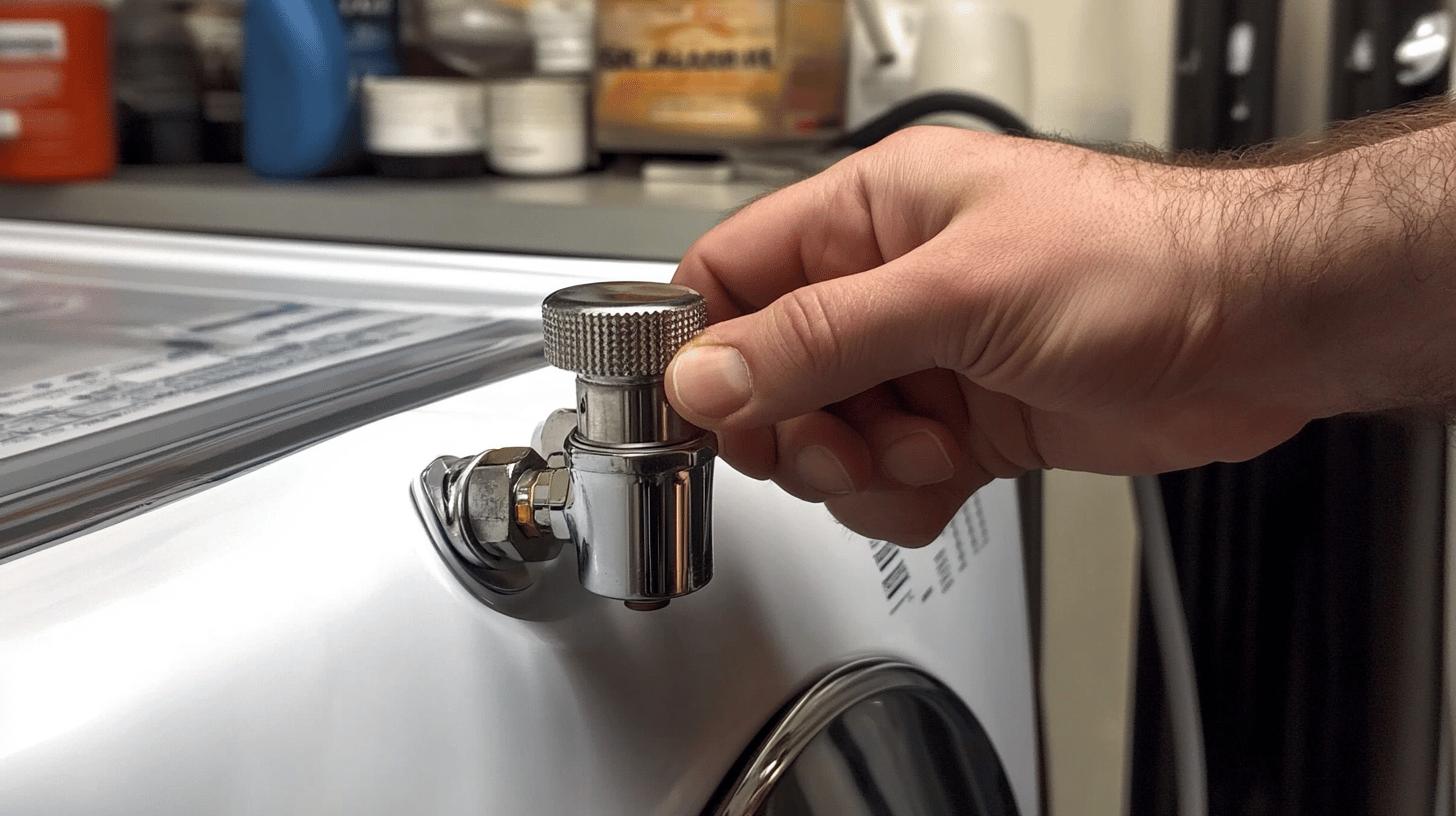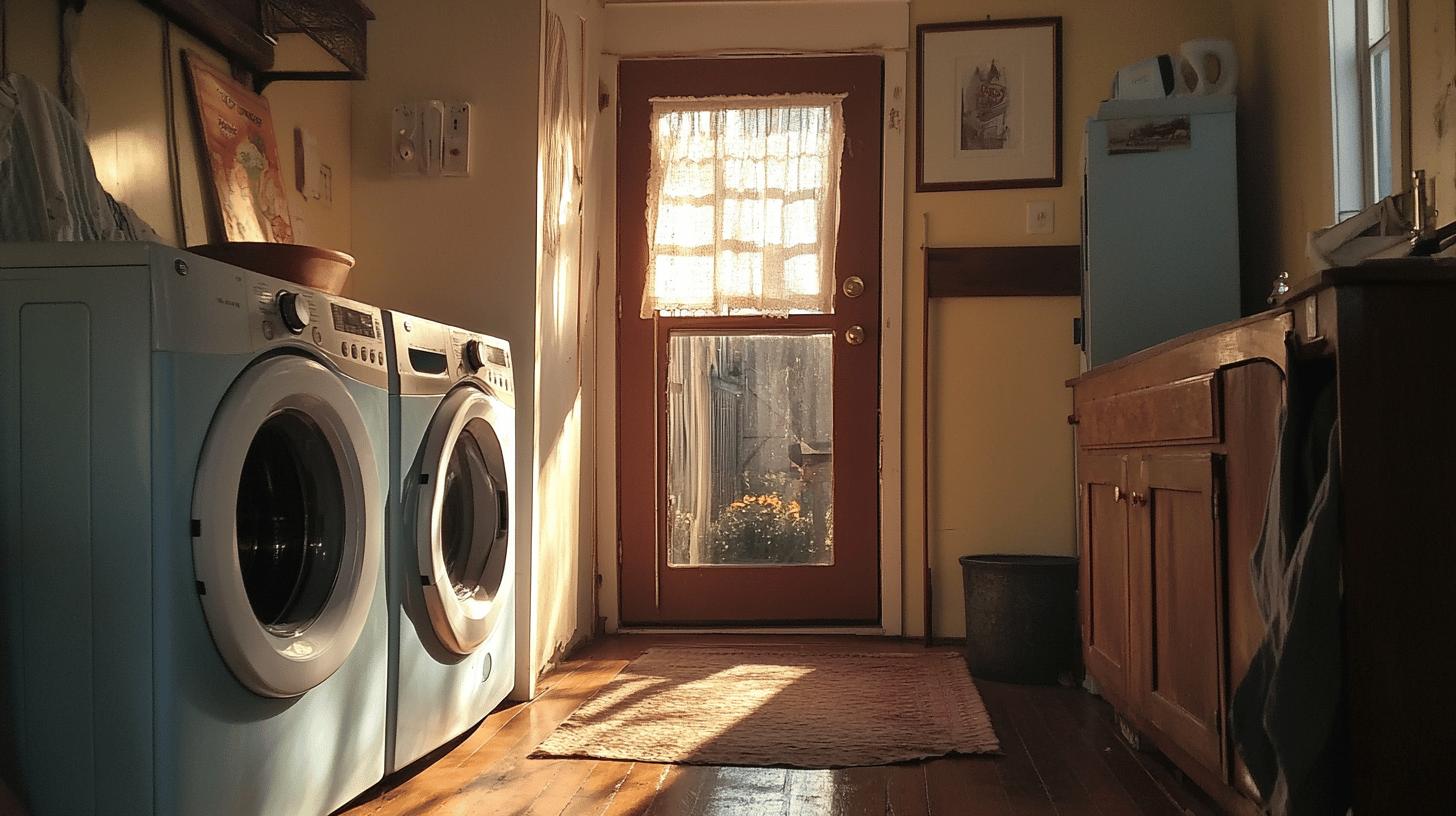TL;DR:
- Locate the washing machine’s shut-off valves behind the appliance (red for hot, blue for cold).
- Turn valves 90 degrees to stop water flow; ensure easy access.
- Check for leaks and test water flow after shutting off.
- For leaks, tighten connections or replace valves; for stuck valves, use a lubricant.
- Regularly inspect valves for wear and consider professional help if issues persist.
- Automatic shut-off valves can prevent flooding by detecting leaks and conserving water, installable with basic tools or by a plumber.
Did you know a washer left unattended can lead to significant water damage if a pipe bursts? Knowing how to turn off the water supply to your washing machine is an essential skill that can save you time, money, and stress in emergencies.
In this guide, you’ll learn how to locate and manage the shut-off valves safely and effectively. Gain confidence and control over your appliance maintenance by understanding these straightforward steps and ensuring a well-protected home. Let’s get started on this important task!
Locating the Shut-Off Valve for Your Washing Machine
When looking for your washing machine’s shut-off valve, start behind the appliance. The valves are typically where the hoses meet the wall, making them easy to reach for maintenance or emergencies. They control water flow to your machine.
These valves often come color-coded: red for hot water and blue for cold. The color coding helps you quickly identify them, ensuring you manage the water flow correctly.
- Ensure you can easily access the area behind your washing machine.
- Look for red and blue handles to identify the hot and cold water lines.
- Make sure you can turn the valves by hand for a quick shut-off.
Step-by-Step Guide to Turning Off the Water Supply

It’s essential to know how to turn off the water supply to your washing machine. This prevents water damage from leaks or when you’re away for a long time. The process is simple and key to avoiding floods or water waste.
- Locate the water valves: Find the red (hot) and blue (cold) handles behind your washing machine where the hoses connect.
- Turn the valves: Rotate each handle 90 degrees to be perpendicular to the pipe. This position means the water is off. Parallel handles mean water flows freely.
- Check for leaks: After turning off the valves, look for any leaks in the hoses or nearby area.
- Test the water flow: Briefly run the machine to ensure no water enters the drum, confirming the supply is off.
- Keep the valves accessible: Make sure nothing blocks access to the valves for future use.
After completing these steps, double-check the handles to make sure they are secure. Regularly inspecting these valves protects against unexpected water issues.
Troubleshooting Common Valve Issues
Leaky washing machine shut-off valves can lead to serious water damage if left unchecked. If you notice any drips, first try tightening the valve connections with a wrench. If this doesn’t help, the valve might need replacement, as worn parts often don’t seal well. If problems persist, consult a professional plumber to avoid further damage.
Stuck valves are another common issue. Over time, mineral deposits or corrosion can make them hard to turn. Avoid forcing them, which might break the valve. Instead, use a lubricant like WD-40 to loosen it. If it’s still stuck, consider replacing it. A plumber can solve the problem without risking plumbing damage.
With regular use, valve wear is natural. Internal parts can degrade, causing poor performance or failure to close. Regular checks and maintenance help prevent issues. If turning the valve is tough or water flow is not consistent, think about replacing it. Professionals offer reliable advice for long-term solutions.
| Issue | Solution |
|————–|———————————————|
| Leaks | Tighten connections or replace the valve |
| Stuck Valves | Use lubricant or replace the valve |
| Valve Wear | Inspect regularly, replace worn components |
Knowing when to call a professional is vital. Complex issues or unsuccessful DIY fixes may need expert intervention for safe and effective repair.
Enhancing Safety with Automatic Shut-Off Valves

Automatic shut-off valves are a smart addition to your washing machine, offering better protection against water damage. They use sensors to detect leaks and immediately shut off the water to prevent flooding. This tech not only avoids damage but also cuts water waste, making it eco-friendly.
Installing an automatic shut-off valve connects to your current plumbing. You can usually do this with basic tools following the manufacturer’s instructions, or via a professional plumber. Once installed, the benefits include water conservation by ending leaks, and reducing costly water damage repairs. These valves are a proactive way to efficiently manage water use at home.
- Automatically prevents water damage by shutting off the supply
- Conserves water by quickly stopping leaks
- Provides peace of mind with reliable leak detection
- Reduces potential plumbing repair costs
Final Words
Knowing how to turn off the water supply to your washing machine can save you time, stress, and prevent water damage. We’ve walked you through how to find the shut-off valve, which has those easy-to-spot red and blue handles, and given you step-by-step instructions to safely stop the water flow. We also talked about how to fix valve issues like leaks to keep your machine working well. Plus, adding automatic shut-off valves gives you extra protection for your home. Use these practical tips to keep your living space efficient and secure.
FAQ
Q: Should the washing machine water valve be on or off?
A: When not using the washing machine, turn the water valve off to prevent leaks and water damage.
Q: How do I turn on the water supply to a washing machine?
A: Turn the water supply handles parallel to the pipes.
Q: What if the washing machine water valve won’t shut off?
A: If the valve won’t shut off, it might need repair or replacement to prevent leaks.
Q: Where is the washing machine shut-off valve located?
A: Shut-off valves are typically behind the machine, where the hoses connect to the wall.
Q: How do I turn off water to my washer?
A: Rotate the water handles 90 degrees until they are perpendicular to the pipes.
Q: Do I need to turn the water off to install a washing machine?
A: Yes, turn off the water valves before installation.
Q: How does a washing machine tap work?
A: The tap controls water flow; turning parallel opens it, perpendicular closes it.
Q: What is a washing machine water valve replacement?
A: Replacing a faulty valve involves removing the old one and installing a new valve to maintain proper water flow.
Q: Is the blue water valve for hot or cold water?
A: The blue handle indicates cold water; red indicates hot water.
Q: How to disconnect the water supply to a washing machine?
A: Shut off the water handles and detach hoses from the wall valves.

